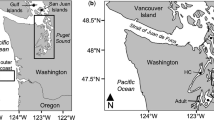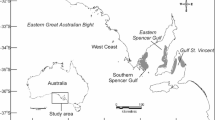Abstract
Quantifying the trophic role of sharks in coastal ecosystems is crucial for the construction of accurate ecosystem models. This is particularly important for wide-ranging species like the Atlantic sharpnose shark (Rhizoprionodon terraenovae), ubiquitous across the northern Gulf of Mexico. We used gut content and stable isotope analyses to determine if differences in abundance of Atlantic sharpnose sharks in the waters around Mobile Bay, Alabama translated into differences in dietary sources or trophic position among sharks sampled east and west relative to the mouth of the bay. Gut content analysis suggested that Atlantic sharpnose sharks eat primarily teleost fishes (%IRI > 90% across size classes), and both stomach content and stable isotope analyses highlighted an ontogenetic shift in diet. Nitrogen stable isotope data from liver and muscle tissues indicated regional shifts in trophic position for Atlantic sharpnose sharks. The mixing model SIAR (stable isotope analysis in R) v.4.0.2 was used to suggest possible contributions from likely prey items for Atlantic sharpnose sharks sampled east and west of Mobile Bay. Portunid crabs and shrimp made higher contributions to the diet of Atlantic sharpnose sharks in the western region, compared to higher and more variable contributions from fish like croaker (Micropogonias undulatus) and hardhead catfish (Arius felis) in the eastern region. Our results suggest trophic plasticity in Atlantic sharpnose sharks, findings that emphasize the importance of examining regional variation in trophic position when constructing coastal foodweb models.






Similar content being viewed by others
References
Barros NB, Ostrom PH, Stricker CA, Wells RS (2009) Stable isotopes differentiate bottlenose dolphins off west-central Florida. Mar Mamm Sci 26(2):324–336
Barry KP (2002) Feeding habits of blacktip sharks, Carcharhinus limbatus, and Atlantic sharpnose sharks, Rhizoprionodon terraenovae, in Louisianna coastal waters. MS thesis, Louisianna State University
Bethea DM, Buckel JA, Carlson JK (2004) Foraging ecology of the early life stages of four sympatric shark species. Mar Ecol Prog Ser 268:245–264
Bethea DM, Carlson JK, Buckel JA, Satterwhite MS (2006) Ontogenetic and site-related trends in the diet of the Atlantic sharpnose shark Rhizoprionodon terraenovae from the northeast Gulf of Mexico. B Mar Sci 78(2):287–307
Carlson JK, Baremore IE (2003) Changes in biological parameters of Atlantic sharpnose shark Rhizoprionodon terraenovae in the Gulf of Mexico: evidence for density-dependent growth and maturity? Mar Freshwater Res 54:277–234
Carlson JK, Brusher JH (1999) An index of abundance for coastal species of juvenile sharks from the northeast Gulf of Mexico. Mar Fish Rev 61:37–45
Carlson JK, Heupel MR, Bethea DM, Hollensead LD (2008) Coastal habitat use and residency of juvenile Atlantic sharpnose sharks (Rhizoprionodon terraenovae). Estuar Coast 31:931–940
Caut S, Angulo E, Courchamp F (2009) Variation in discrimination factors (∆15N and ∆13C): the effect of diet isotopic values and applications for diet reconstruction. J Appl Ecol 46:443–453
Chipps SR, Garvey JE (2007) Assessment of diets and feeding patterns. In: Cs G, Brown ML (eds) Analysis and interpretation of freshwater fisheries data. American Fisheries Society, Bethesda, pp 473–513
Clark E, von Schmidt K (1965) Sharks of the Central Gulf coast of Florida. B Mar Sci 15:13–83
Cortés E (1997) A critical review of methods of studying fish feeding based on analysis of stomach contents: application to elasmobranch fishes. Can J Fish Aquat Sci 54:724–738
Cortés E (1999) Standardized diet compositions and trophic levels of sharks. ICES J Mar Sci 56:707–717
Cortés E (2002) Stock assessment of small coastal sharks in the U.S. Atlantic and Gulf of Mexico. USDOC, NOAA, NMFS, SEFSC, Miami. Sustainable Fisheries Division Contribution No. SFD-01/02-152
DeNiro MJ, Epstein S (1978) Influence of diet on the distribution of carbon isotopes in animals. Geochim Cosmochim Ac 42:495–506
Driggers WB, Ingram GW, Grace MA, Gledhill CT, Henwood TA, Horton CN, Jones CM (2008) Pupping areas and mortality rates of young tiger sharks Galeocerdo cuvier in the western North Atlantic Ocean. Aquat Biol 2:161–170
Drymon JM (2010) Distributions of coastal sharks in the northern Gulf of Mexico: consequences for trophic transfer and foodweb dynamics. Dissertation, University of South Alabama
Drymon JM, Powers SP, Dindo J, Dzwonkowski B, Henwood TA (2010) Distributions of sharks across a continental shelf in the northern Gulf of Mexixo. Mar Coast Fish 2:440–450
Estrada JA, Rice AN, Lutcavage ME, Skomal GB (2003) Predicting trophic position in sharks of the north-west Atlantic Ocean using stable isotope analysis. J Mar Biol Assoc UK 83:1347–1350
Fisk AT, Tittlemier SA, Pranschke JL, Norstrom RJ (2002) Using anthropogenic contaminants and stable isotopes to assess the feeding ecology of Greenland sharks. Ecology 83(8):2162–2172
Folch J, Lees M, Stanley GHS (1957) A simple method for the isolation and purification of total lipids from animal tissues. J Biol Chem 226:497–509
Hobson KA, Welch HE (1992) Determination of trophic relationships within a high Arctic marine food web using 13C and 15N analysis. Mar Ecol Prog Ser 84:9–18
Hoffmayer ER, Parsons GR (2003) Food habits of three shark species from the Mississippi Sound in the northern Gulf of Mexico. Southeast Nat 2(2):271–280
Holl CM, Villareal TA, Payne CD, Clayton TD, Hart C, Montoya JP (2007) Trichodesmiun in the western Gulf of Mexico: 15N2-fixation and natural abundance stable isotope evidence. Limnol Oceanogr 52(5):2249–2259
Hussey NE, Brush J, McCarthy ID, Fisk AT (2010) δ15N and δ13C diet-tissue discrimination factors for large sharks under semi-controlled conditions. Comp Biochem Physiol A 155:445–453
Hyslop EJ (1980) Stomach content analysis: a review of methods and their application. J Fish Biol 17:411–229
Inger R, McDonald RA, Rogowski D, Jackson AL, Parnell A, Preston SJ, Harrod C, Goodwin C, Griffiths D, Dick JTA, Elwood RW, Newton J, Bearhop S (2010) Do non-native invasive fish support elevated lamprey populations? J Appl Ecol 47:121–129
Kitchell JF, Essington TE, Boggs CH, Schindler DE, Walters CJ (2002) The role of sharks and longline fisheries in a pelagic ecosystem of the Central Pacific. Ecosystems 5:202–216
Loefer JK, Sedberry GR (2003) Life history of the Atlantic sharpnose shark (Rhizoprionodon terraenovae) (Richardson, 1836) off the southeastern United States. Fish Bull 101:75–88
Logan JM, Lutcavage ME (2010) Stable isotope dynamics in elasmobranch fishes. Hydrobiologia 644:231–244
Logan JM, Jardine TD, Miller TJ, Bunn SE, Cunjak RA, Lutcavage ME (2008) Lipid correction in carbon and nitrogen stable isotope analyses: comparison of chemical extraction and modeling methods. J Anim Ecol 77:838–846
MacNeil MA, Skomal GB, Fisk AT (2005) Stable isotopes from multiple tissues reveal diet switching in sharks. Mar Ecol Prog Ser 302:199–206
MacNeil MA, Drouillard KG, Fisk AT (2006) Variable uptake and elimination of nitrogen isotopes. Can J Fish Aquat Sci 63:345–353
McCutchan JH, Lewis WM, Kendall C, McGrath CC (2003) Variation in trophic shift for stable isotope ratios of carbon, nitrogen and sulfur. Oikos 102:38–290
McMeans BC, Olin JA, Benz GW (2009) Stable-isotope comparisons between embryos and mothers of a placentatrophic shark species. J Fish Biol 75:2464–2474
Moncreiff CA, Sullivan MJ (2001) Trophic importance of epiphytic algae in subtropical seagrass beds: evidence from multiple stable isotope analyses. Mar Ecol Prog Ser 215:93–106
Park R, Epstein S (1961) Metabolic fractionation of C13 & C12 in plants. Plan Physiol 36:133–138
Parnell AC, Inger R, Bearhop S, Jackson AL (2010) Source partitioning using stable isotopes: coping with too much variation. PLoS One 5(3):1–5
Parsons GR (1983) The reproductive biology of the sharpnose shark, Rhizoprionodon terraenovae (Richardson). Fish Bull 81:61–73
Parsons GR, Hoffmayer ER (2005) Seasonal changes in the distribution and relative abundance of the Atlantic sharpnose shark Rhizoprionodon terraenovae in the North Central Gulf of Mexico. Copeia 4:914–920
Peterson BJ, Fry B (1987) Stable isotopes in ecosystem studies. Annu Rev Ecol Syst 18:293–320
Piankas LM, Oliphant S, Iverson ILK (1971) Food habits of albacore, bluefin tuna and bonito in California waters. Calif Fish Game 152:1–105
Polunin NVC, Pinnegar JK (2002) Trophic ecology and the structure of marine food webs. In: Hart P, Reynolds J (eds) Handbook of fish and fisheries, Vol 1. Blackwell Science, Oxford, pp 301–320
Post DM (2002) Using stable isotopes to estimate trophic position: models, methods, and assumptions. Ecology 83(3):703–718
Post DM, Layman CA, Arrington DA, Takimoto G, Quattrochi J, Montana GC (2007) Getting to the fat of the matter: models, methods and assumptions for dealing with lipids in stable isotope analyses. Oecologia 152:179–189
Rice WR (1989) Analyzing tables of statistical tests. Evolution 43(1):223–225
Rush SA, Olin JA, Fisk AT, Woodrey MS, Cooper RJ (2010) Trophic relationships of a marsh bird differ between gulf coast estuaries. Estuar Coasts 33(4):963–970
Sminkey TR, JA Musick (1995) Age and growth of the sandbar shark, Carcharhinus plumbeus, before and after population depletion. Copeia 871–883
Stevens JD, Bonfil R, Dulvy NK, Walker PA (2000) The effects of fishing on sharks, rays and chimaeras (chondrichthyans), and the implications for marine ecosystems. ICES J Mar Sci 57:476–494
Sweeting CJ, Barry J, Barnes C, Polunin NVC, Jennings S (2007) Effects of body size and environment on diet-tissue delta N-15 fractionation in fishes. J Exp Mar Biol Ecol 340:1–10
Vander Zanden MJ, Rassmussen JB (2001) Variation in δ15N and δ13C trophic fractionation: implications for aquatic foodweb studies. Limnol Oceanogr 46(8):2061–2066
Vaudo JJ, Matich P, Heithaus MR (2010) Mother-offspring isotope fractionation in two species of placentatrophic sharks. J Fish Biol 77:1724–1727
Wolf N, Carleton SA, Martinez del Rio C (2009) Ten years of experimental animal isotopic ecology. Funct Ecol 23:17–26
Acknowledgements
This work was funded by the National Marine Fisheries Service and the Dauphin Island Sea Lab. Funding for the stable isotope analysis was provided by the Mississippi/Alabama SeaGrant Consortium. Special thanks to Brian Fry for analyzing preliminary stable isotope samples free of charge. Thanks to John Mareska for providing coastal trawl data from the Alabama Marine Resources Division survey, and special thanks to the biologists who provided samples from that survey. The authors owe thanks to Andrea Kroetz, who was an invaluable part of field and laboratory work. Thanks go to vessel captains Butch Sutton and Kendall Falana from the NMFS R/V HST, Lionel Laforce and James Barbour from the NMFS R/V Gandy, Drew Hopper and David Saska from the NMFS R/V Caretta, and Tom Guoba, Clark Lollar and Rodney Collier from the DISL R/V E.O. Wilson. This manuscript was improved by helpful comments and revisions from Enric Cortés, and two anonymous reviewers.
Author information
Authors and Affiliations
Corresponding author
Rights and permissions
About this article
Cite this article
Drymon, J.M., Powers, S.P. & Carmichael, R.H. Trophic plasticity in the Atlantic sharpnose shark (Rhizoprionodon terraenovae) from the north central Gulf of Mexico. Environ Biol Fish 95, 21–35 (2012). https://doi.org/10.1007/s10641-011-9922-z
Received:
Accepted:
Published:
Issue Date:
DOI: https://doi.org/10.1007/s10641-011-9922-z




